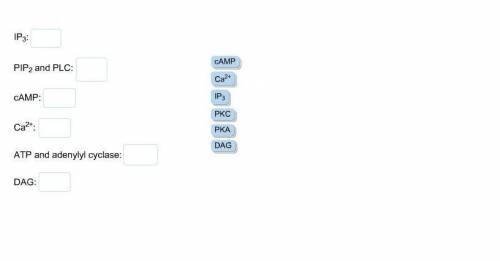
Chemistry, 29.02.2020 04:58 cfnewton09
G protein‑coupled receptors (GPCRs) transform external stimuli to intracellular signals. The G protein associated with the receptor is activated by ligand binding, regulating an enzyme that produces a second messenger. The second messenger, in turn, brings about changes within the cell. Components of two common second messenger pathways are given. Identify the next component of each signaling pathway. Each compound or ion may be used once or more than once. One target requires two answers. The given abbreviations are used: cAMP, cyclic AMP; DAG, diacylglycerol; IP3, inositol triphosphate; PIP2, phosphatidylinositol 4,5‑bisphosphate; PKA, protein kinase A (cAMP‑dependent protein kinase); PKC, protein kinase C; PLC, phospholipase C.

Answers: 3


Another question on Chemistry

Chemistry, 22.06.2019 08:00
Which of the following observations indicates that there is a small, dense, positively charged part in the center of an atom? some uncharged particles are scattered by a gold foil. all uncharged particles are attracted towards a gold foil. all positively charged particles pass straight through a gold foil. some positively charged particles bounce back from a gold foil.
Answers: 2

Chemistry, 22.06.2019 09:20
Explain that newton first law,second law and third law of motion?
Answers: 2

Chemistry, 22.06.2019 10:20
In a reaction equation, where are the products located? a.) above the arrow b.) to the right of the arrow c.) to the left of the arrow d.) below the arrow
Answers: 2

Chemistry, 22.06.2019 14:30
Connect the whole numbers on the periodic table to indicate what they represent?
Answers: 3
You know the right answer?
G protein‑coupled receptors (GPCRs) transform external stimuli to intracellular signals. The G prote...
Questions






Social Studies, 15.02.2021 07:00

Mathematics, 15.02.2021 07:00

History, 15.02.2021 07:00

Mathematics, 15.02.2021 07:00




English, 15.02.2021 07:00



History, 15.02.2021 07:00



Mathematics, 15.02.2021 07:00

Health, 15.02.2021 07:00




